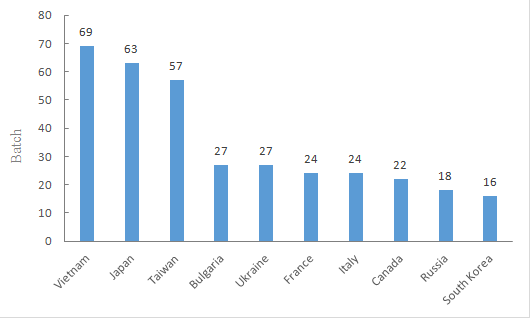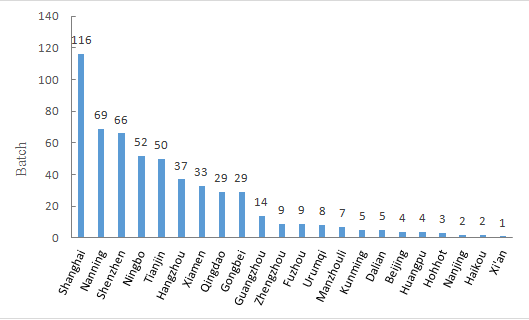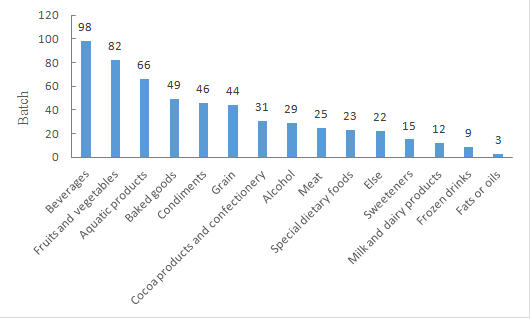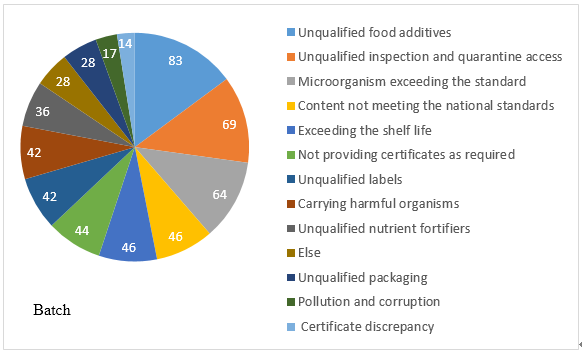According to the statistics of the food not allowed to enter the country from January to June 2019 issued by the General Administration of Customs of the People's Republic of China, in the first half of 2019, after being found to be unqualified for safety and health, 554 batches of food from 49 countries and regions were not allowed to enter China.
1. Country/region of origin of non-entry food
Food not allowed to enter China were imported from Vietnam, Japan, Taiwan, Bulgaria, Ukraine, France, Italy, Canada, Russia, South Korea, the United Kingdom, Venezuela, and other 49 countries or regions. Among all the countries/ regions, Vietnam, Japan and Taiwan ranked the top three in the number of non-entry food.

Figure 1 The top 10 food producing areas without entry permit
2. Non-entry food rejecting ports
There were 22 ports rejecting the food products, including Shanghai, Nanning, Shenzhen, Ningbo, Tianjin, Hangzhou, Xiamen, Qingdao, Gongbei, Guangzhou, Zhengzhou, Fuzhou, Urumqi, Manzhouli, Kunming, Dalian, Beijing, Huangpu, Hohhot, Nanjing, Haikou, Xi'an. Among them, Shanghai, Nanning and Shenzhen ranked the top three in the number of rejection on the food products.

Figure 2 Non-entry food rejecting ports
3. Non-entry food category
Non-entry food mainly include beverages, fruits and vegetables, aquatic products, baked goods, condiments, grain products, cocoa products and confectionery, alcohol, meat, special dietary foods, sweeteners, milk and dairy products, frozen drinks, fats or oils, etc. Among them, beverages accounted for 17.7%, fruits and vegetables accounted for 14.8%, and aquatic products accounted for 11.9%.

Figure 3 Non-entry food category
4. Reasons and analysis on the non-entry food
The main reasons for the non-entry food were unqualified food additives, unqualified inspection and quarantine access, microorganism exceeding of the standard, content not meeting the national standards, exceeding of shelf life, not providing certificates as required, unqualified labels, carrying of harmful organisms, unqualified nutrient fortifiers, unqualified packaging, pollution and corruption, certificate discrepancy, etc. Among them, there were 83 batches of foods with unqualified food additives, 69 batches of foods that were not approved for inspection and quarantine, and 64 batches of foods with excessive microbial counts.

Note: Other reasons include: detection of chloramphenicol, detection of unapproved genetically modified ingredients, detection of epidemics, etc.
Figure 4 Reasons and analysis of non-entry food
Above is the summary and analysis from CIRS on non-entry food released by the General Administration of Customs from January to June 2019. In general, the main reasons for food inaccessibility were unqualified food additives, unqualified inspection and quarantine access and microorganism exceeding the standard. Adequate preparation before import can effectively help enterprises reduce the risks of unqualified products when importing. For example, in terms of the problem of unqualified food additives, the importer should complete the formula compliance analysis before the product is imported, and the use of food additives should meet the requirements in GB 2760. In terms of the problem of unqualified inspection and quarantine, before importing products, importers could consult the "Catalogue Information System of Food Delivered to China by Countries or Regions Meet the Requirements of Assessment and Examination and Traditionally Trade" to make sure that relevant products have been admitted to China for import inspection and quarantine. Besides, in terms of the problem of exceeding the standard of microorganisms, CIRS suggests that before importing products, importers should firstly test the conformity of products to national standards to ensure that their microbial indicators meet the requirements of national standards. Secondly, they should pay attention to the storage conditions of products to avoid environmental factors leading to microbial pollution.
If you have any needs or questions, please contact us at service@cirs-group.com.

